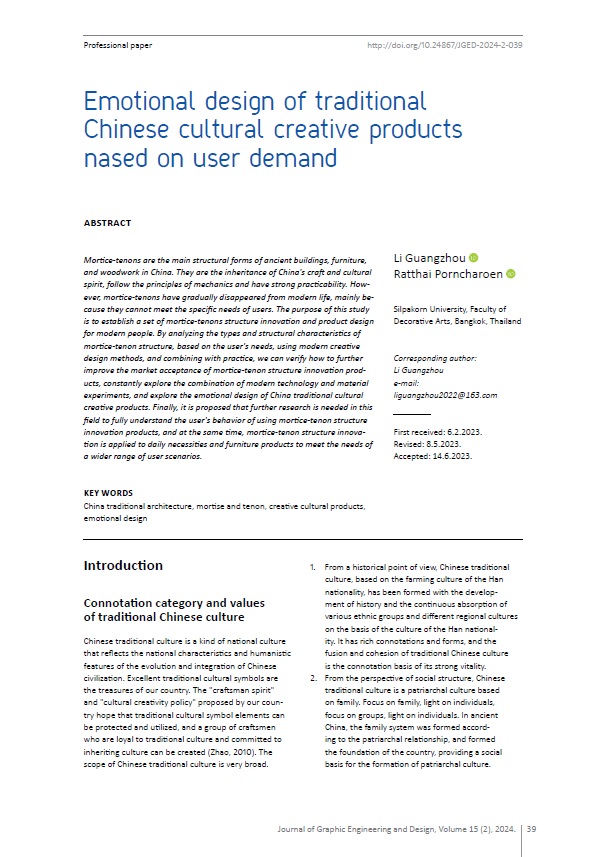Emotional design of traditional Chinese cultural creative products based on user demand

Published 2024-06-01
abstract views: 521 // Full text article (PDF): 411
Keywords
- China traditional architecture,
- mortise and tenon,
- creative cultural products,
- emotional design
How to Cite
Abstract
Mortice-tenons are the main structural forms of ancient buildings, furniture, and woodwork in China. They are the inheritance of China's craft and cultural spirit, follow the principles of mechanics and have strong practicability. However, mortice-tenons have gradually disappeared from modern life, mainly because they cannot meet the specific needs of users. The purpose of this study is to establish a set of mortice-tenons structure innovation and product design for modern people. By analyzing the types and structural characteristics of mortice-tenon structure, based on the user's needs, using modern creative design methods, and combining with practice, we can verify how to further improve the market acceptance of mortice-tenon structure innovation products, constantly explore the combination of modern technology and material experiments, and explore the emotional design of China traditional cultural creative products. Finally, it is proposed that further research is needed in this field to fully understand the user's behavior of using mortice-tenon structure innovation products, and at the same time, mortice-tenon structure innovation is applied to daily necessities and furniture products to meet the needs of a wider range of user scenarios.
Dimensions Citation Metrics
References
- Deng, Y., Chen, Z. & Zhou, M. (2020) Research on the application of mortise and tenon structure in jewelry innovation design. Industrial Design. 2020 (5), 145-146.
- Guo, H. & Wang, J. (2018) Wood play teaching AIDS - Lu Ban lock charm. Art Mirror. 24, 22-23.
- Han, X. & Deng, R. (2022) Emotional design strategy of intelligent products based on EEI model. Design. 35 (7), 90-93.
- Lan, T. (2019) Analysis on the application of mortice- tenon structure in product design. Journal of Beijing Institute of Printing. 27 (11), 3.
- Li, Y. & Zhang, D. (2012) Consumer forest · Brand regeneration. Shanghai, Shanghai Sanlian Culture Publishing House.
- Lin, H., Peng, L., Li, Y. & Cang, S. (2022) The application of Mortise and Tenon Joint in the Design of Children's Building Block Toys. Design. 7 (2), 15-22. Available from: doi: 10.12677/Design.2022.72003
- Shao, Y. (2019) The development of mortice-tenon structure in traditional furniture. Modern and ancient legends: Cultural Review. 2019 (5).
- Wang, X. & Fan, C. (2016) Humanization and emotion of cultural and creative product design. Social Sciences in Chongqing. 12, 101-106.
- Wang, S. & Yang, R. (2022) Research on the application of visual formal language in emotional design of tourism product packaging. China Packaging. 42 (8), 49-52.
- Xu, S. & Guo, W. (2020) Analysis of Jiangnan Classical Gardens Based on Emotional Design Theory. Art of Design. 2020 (6), 13-18.
- Zhao, C. (2010) Analysis on the practice of traditional cultural elements in cultural and creative product design. Textile Industry and Technology. 50 (6), 89-92.
- Zhu, X., Ma, Z. & Deng, H. (2022) Emotional design research and practice of Chaowan cultural and creative products. Industrial Innovation Research. 2022 (13), 72-74.


